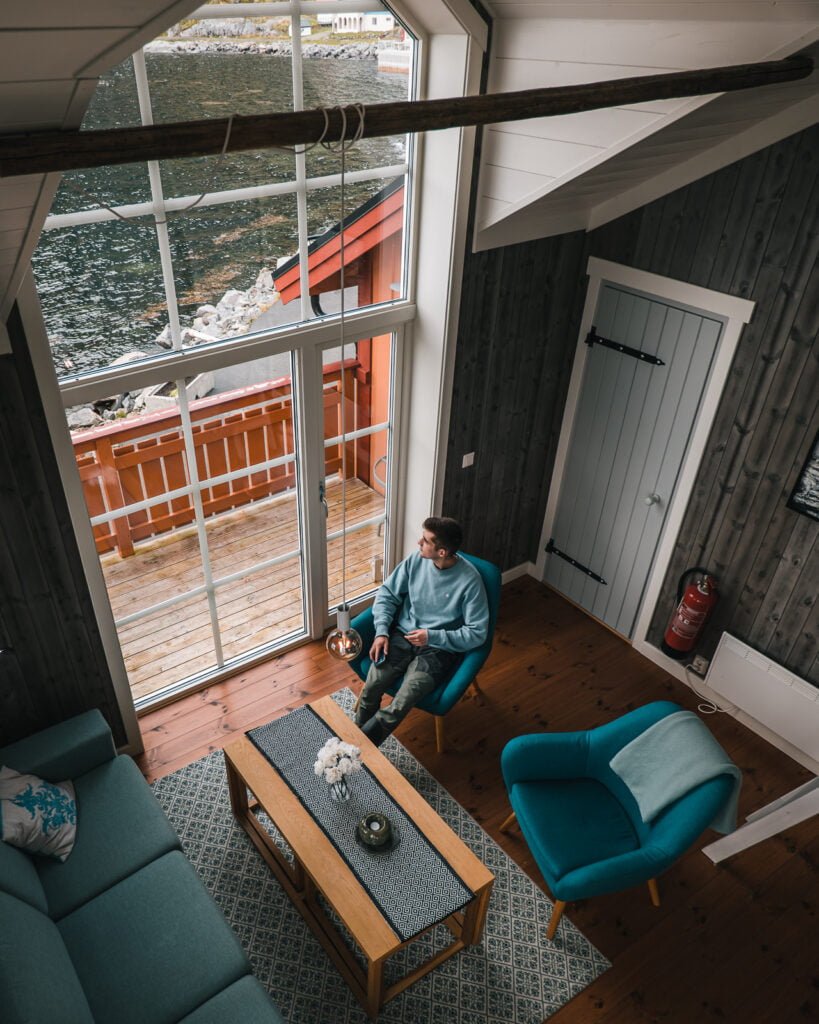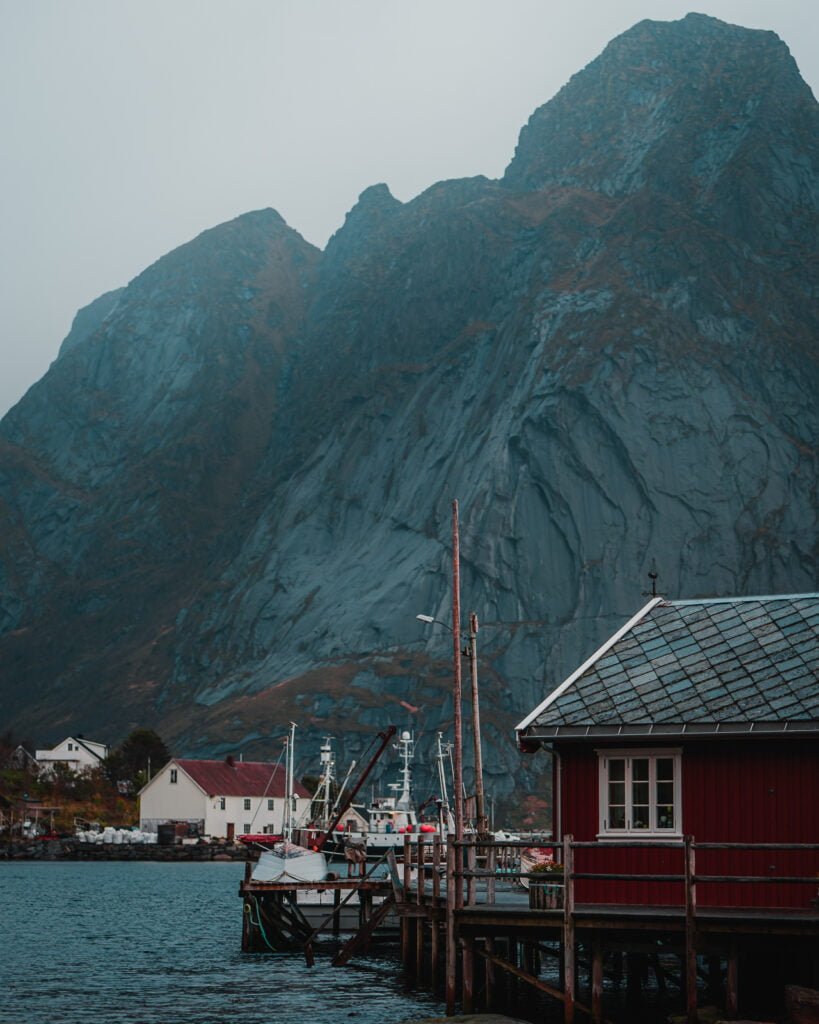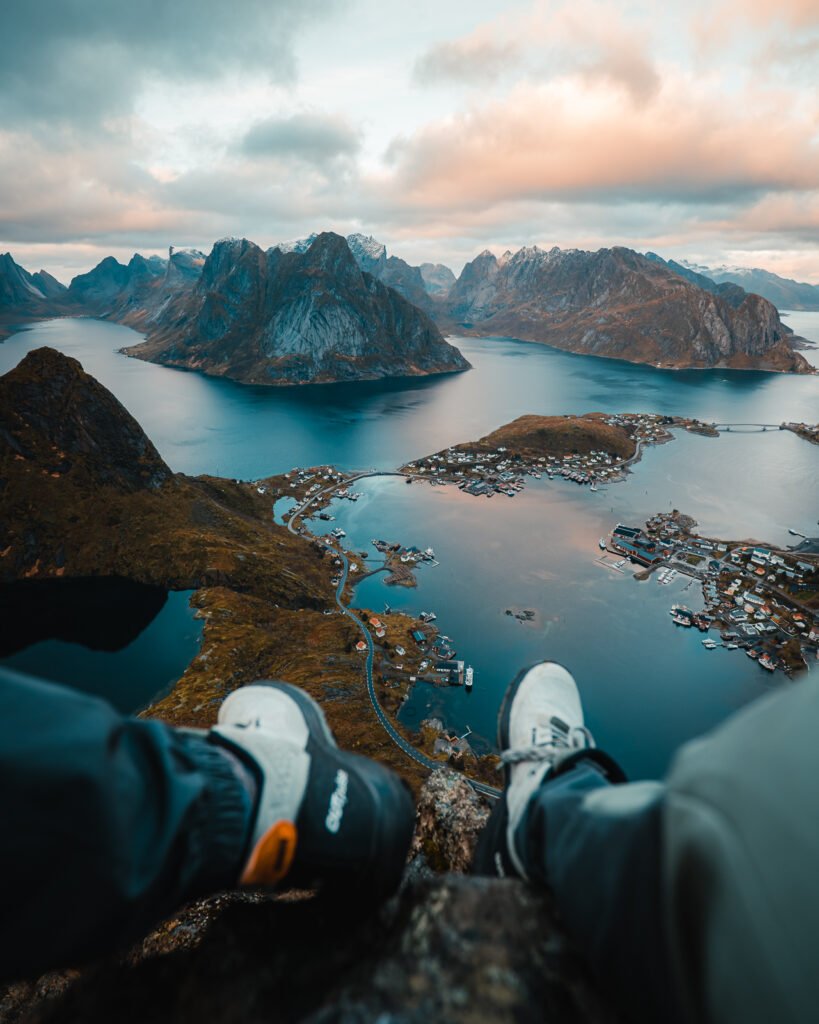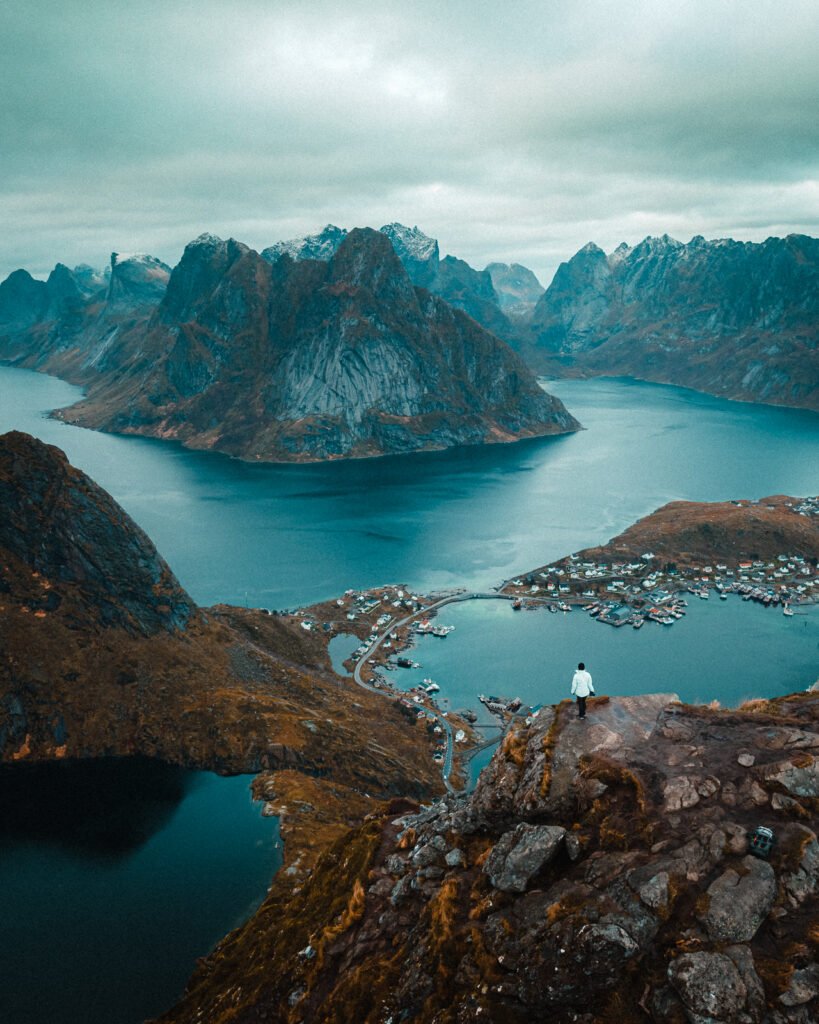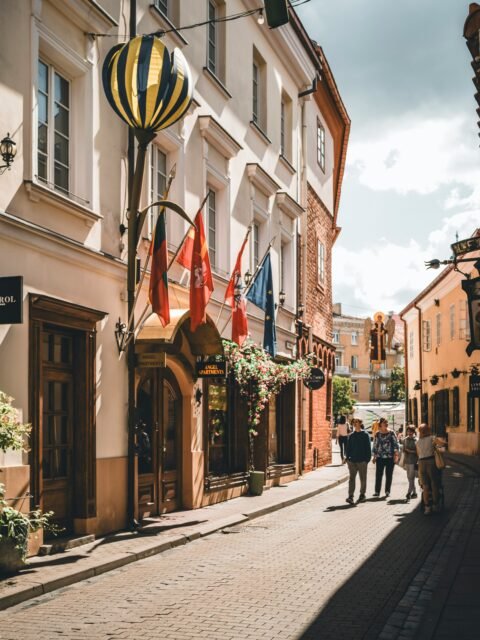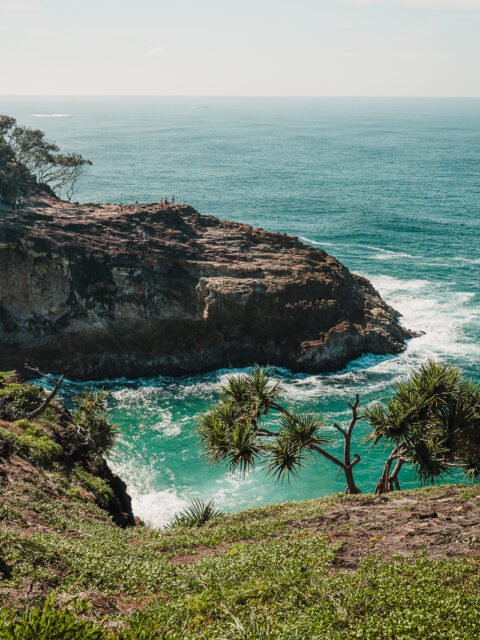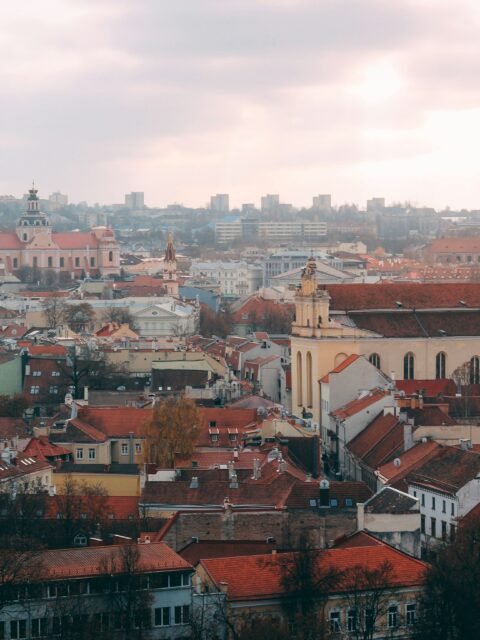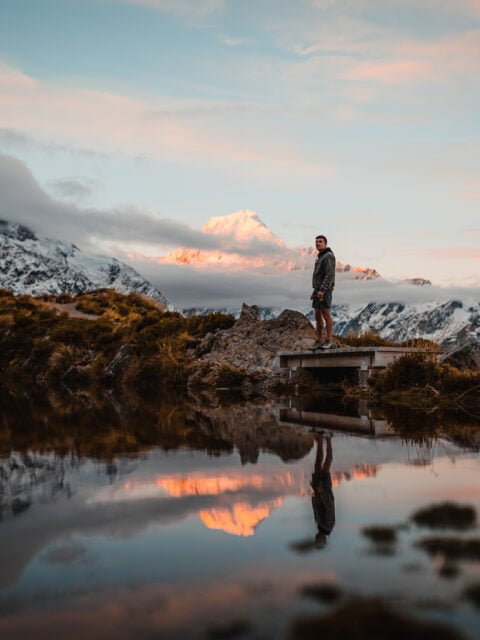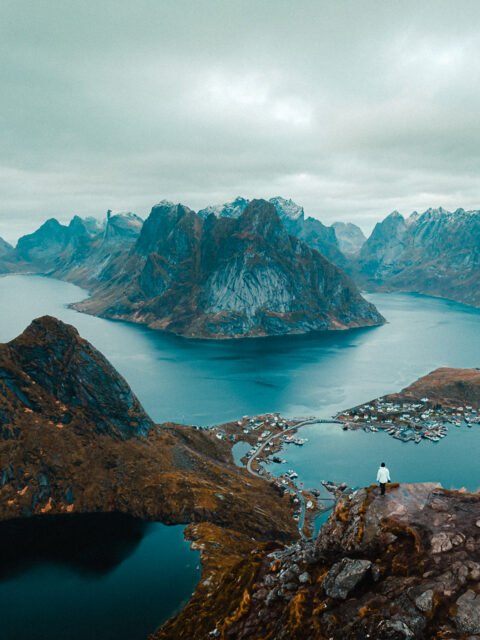The Lofoten Islands, located above the Arctic Circle in Norway, are a dream destination for outdoor and adventure lovers. Known for their dramatic landscapes of rugged mountains, deep fjords and picturesque fishing villages, the Lofoten Islands are the perfect destination for hiking, breathtaking views and beautiful photography spots.

How to Get Around the Lofoten Islands
Renting a car is by far the most convenient way to get around the Lofoten Islands, as it allows you to access remote areas and gives you the flexibility to explore on your own schedule.
The Lofoten Islands is a relatively small area, so it doesn’t take long to drive to each location. However, be prepared for narrow, winding roads, bridges and tunnels.
Rent a Car
Car rentals in Lofoten are available at airports and large towns, such as Evenes Airport (Harstad/Narvik Airport) and Svolvær Airport, as well as in the town of Svolvær.
Evenes Airport is a common choice for those arriving from abroad, as it is well-connected with flights from major cities in Norway and Europe. Svolvær Airport is smaller but is closer to the central Lofoten region.
Public Transport
If you prefer to not drive, buses and ferries are available, but they may limit your schedule. The bus system is operated by Torghatten Nord, with routes connecting the main towns such as Svolvær, Leknes, and Å. However, the frequency of buses can be low, particularly outside the summer season.
Ferries are an integral part of transportation in Lofoten, connecting the islands with the mainland and other islands. The Bodø to Moskenes ferry is the most common entry point for travellers coming from the mainland.
Where to Stay in the Lofoten Islands
Where you stay in the Lofoten Islands depends on what experience you’re after. You can choose to stay in the largest town Svolvær, or small villages like Reine, Nusfjord and Å; or you can stay in different locations across this road-trip, to save on driving time.
Staying in a rorbu (traditional fisherman’s cabin) is a quintessential Lofoten experience. These cabins, originally used by fishermen, have been converted into cosy accommodations, while keeping their rustic and authentic features.
Reine is a picturesque fishing village tucked away in the mountains, and is often described as one of the most beautiful villages in the world. We stayed in Reinefjorden Sjohus, which has waterfront rorbu cabins with breathtaking views of the fjord.
This was a great location for exploring this part of Lofoten, and the cabins were cosy, picturesque and had everything you could need.
If you’re travelling in a campervan, then there are a few campsites located around, and you do have the option of free camping. Moskenes Camping is a popular spot, offering facilities for tents, caravans, and campervans.
PLACES TO STAY
Top Rated Accommodation

Reinefjorden Sjøhus

Thon Hotel Lofoten

FURU Hostel & Café
What is the Best Time of Year to Visit the Lofoten Islands
The Lofoten Islands are stunning year-round, but the best time to visit depends on what you want to experience:
Summer (June to August)
Warm and sunny (10°C to 15°C), perfect for hiking, kayaking, and experiencing the midnight sun. This is the peak tourist season, so expect higher prices and more crowds.
Autumn (September to November)
Cooler temperatures (5°C to 10°C), with stunning autumn colours and the return of the Northern Lights. Fewer tourists and ideal for photography, but days get shorter and weather can be unpredictable.

Winter (December to February)
Cold and snowy (-1°C to 4°C), offering the best chances to see the Northern Lights and enjoy winter sports. Quiet and peaceful, but with limited daylight and some road closures due to snow.

Spring (March to May)
Mild temperatures (2°C to 10°C), with longer days and blooming landscapes. Outdoor activities can start again, but the weather can be unpredictable.
How to reach the Lofoten Islands
Reaching the Lofoten Islands does require a bit of planning, but there are many different options you can take depending on how you’re travelling.
Airplane
The most convenient way to reach the Lofoten Islands is by flying. The nearest airports are Leknes Airport and Svolvær Airport, both of which have frequent flights from major cities like Oslo and Tromsø.
Another option is to fly into Harstad/Narvik Airport in Evenes. From there, you can rent a car and drive to Lofoten, which takes about 4 to 5 hours.
Ferry
For those who prefer a more scenic route, taking the ferry from Bodø to the Lofoten Islands is a great option. Ferries run year-round, with routes to Moskenes, Værøy, and Røst. The journey takes about 3 to 4 hours and offers stunning views of the Norwegian Sea and the surrounding islands.
Another ferry option is from Skutvik on the mainland to Svolvær or Skrova in the Lofoten Islands. This route is also very scenic and takes about 1.5 to 2 hours.
Car
If you’re planning a road trip, you can drive to the Lofoten Islands from the mainland, which is what we did. From Narvik, take the E10 Highway which connects the Lofoten Islands to the mainland.
The drive from Narvik to the islands takes about 4 to 5 hours and is filled with picturesque landscapes, including fjords, mountains, and charming villages. If you’re driving from Bodø, you can take your car on the ferry to Moskenes or other destinations in Lofoten.
Day 1: Arrive in Svolvær and Visit Henningsvær
This Lofoten Islands Itinerary starts in Svolvær, the biggest town in Lofoten. Located on the island of Austvågøya, Svolvær is a charming town known for its picturesque harbour and easy access to the rest of the Lofoten Islands. After settling in and picking up a hire car, you can take some time to explore Svolvær.
Svolværgeita (The Svolvær Goat)
This twin-peaked mountain is a must-see, especially for climbers and hikers. You can take a guided climb to the top, which offers incredible views of the surrounding area. Even if you’re not looking to climb, it still makes for a great photo opportunity.
Svolvær Harbor
Visit the picturesque harbour, where you’ll find colourful fishing boats, local seafood restaurants, and art galleries. You’ll be able to spot some of the iconic red rorbuer cabins (fishermen cabins).
Explore Henningsvær
In the afternoon, take the scenic 25-minute drive from Svolvær to the picturesque fishing village of Henningsvær.
Henningsvær Football Pitch
The Henningsvær Football Pitch is a must-see in the Lofoten Islands, and is one of the most famous football pitches in the world. The stadium is located on a rocky tip surrounded by the sea, with towering mountains in the background.
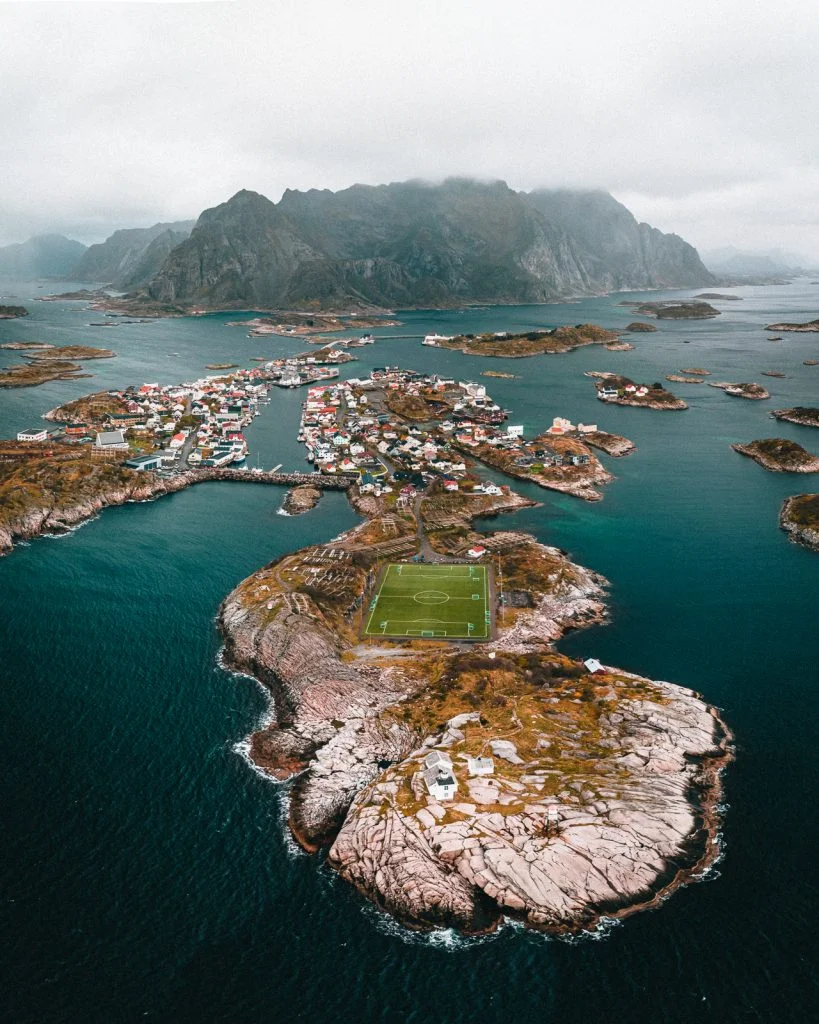
Even if you’re not a football fan, it’s worth visiting for the incredible setting and photo opportunities. It’s an epic spot for drone photography!
Festvågtind Hike in Henningsvær
If you enjoy a scramble in the mountains, consider hiking Festvågtind, a short but steep hike that offers a beautiful view over Henningsvær. It’s a challenging hike that requires a decent level of fitness and scrambling ability, with 500m in incline. It’s also only worth doing on a clear day, so you can take in the rewarding views from the top.
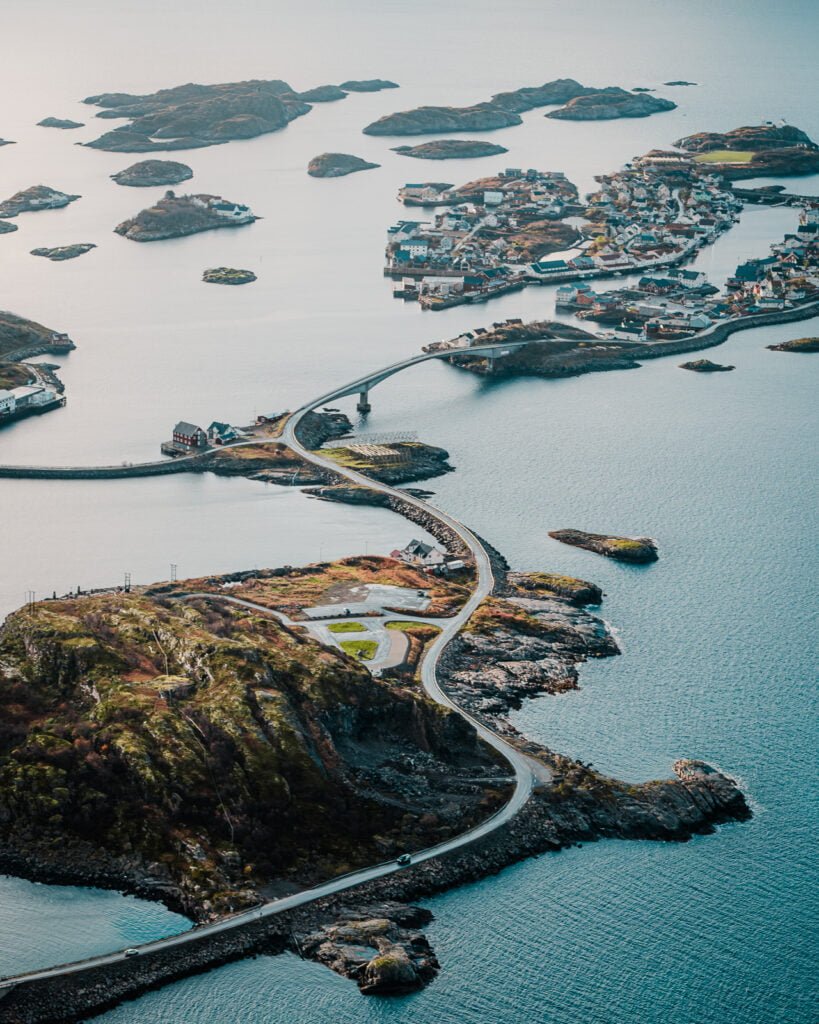
Explore the Village
Wander through Henningsær’s unique village, reminiscent of Venice, with its small islands connected by bridges and narrow streets. Make sure to stop at one of the many quaint cafes for a traditional cinnamon bun also known as ‘kanelboller’.
Day 2: Hauklandstranda and Mannen Hike
The second day of this Lofoten Islands itinerary takes you to one of the most beautiful beaches in Norway, Hauklandstranda, and an incredible hike up to Mannen for panoramic views of the surrounding landscapes.
Hauklandstranda
Known for its pristine white sand and turquoise waters, Hauklandstranda is often considered one of the most beautiful beaches in Norway.
Even though the water might be cold, the scenery is breathtaking, making it a perfect spot for a relaxing swim and some photography.
Mannen Hike
After enjoying the beach, get ready to hike to Mannen, a moderate trail that offers incredible views over Hauklandstranda and the surrounding area.
The trail to Mannen is approximately 2 km one way, with an elevation gain of about 400 m, and takes roughly 2-3 hours round-trip.
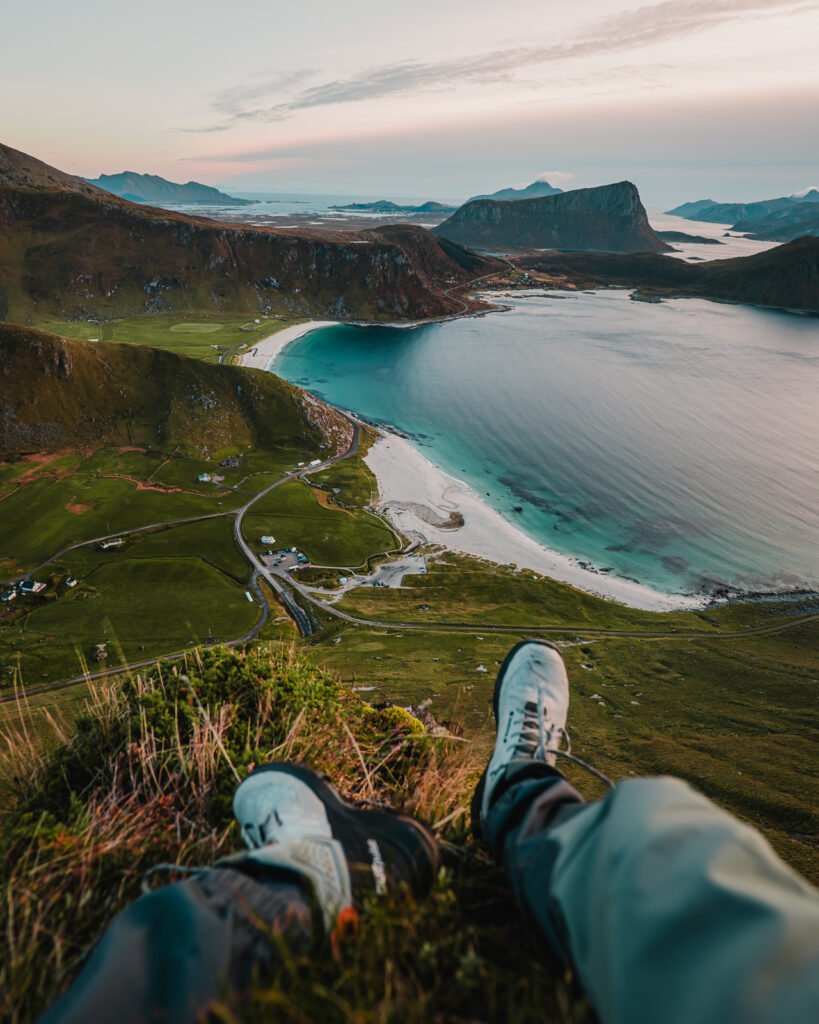
Once you reach the summit, you’ll be rewarded with incredible views of the turquoise waters, rugged coastline, and distant peaks.
Day 3: Rambergstranda, Kvalvika Beach and Ryten Hike
Day 3 of your Lofoten adventure takes you to two of the islands’ most iconic beaches: the serene Rambergstranda and the remote, Kvalvika Beach, as well as the Ryten Hike.
Rambergstranda
On your way to Kvalvika Beach, stop off at Rambergstranda, a beautiful beach known for its soft, white sand and crystal-clear waters, set against the backdrop of towering mountains.
Rambergstranda is perfect for a peaceful morning walk, or simply relaxing and soaking in the tranquil atmosphere. After exploring Rambergstranda, head towards Kvalvika Beach, which is a 30-minute drive.
Kvalvika Beach
Kvalvika Beach is famous for its dramatic setting and the feeling of being completely disconnected from the rest of the world. To reach this remote beach you’ll have to hike 2 km, which takes around 1 to 1.5 hours each way.
The hike is moderately challenging, with some steep sections, but it’s well worth the effort. Once you arrive, you’ll be greeted by one of Lofoten’s most stunning beaches, surrounded by steep cliffs and rugged mountains.

Hike to Ryten
If you have the time and energy, consider hiking to the summit of Ryten, which sits above Kvalvika Beach. This hike adds an additional 3.5km and 543m in elevation.

The view from the top is breathtaking, offering a bird’s-eye view of Kvalvika Beach and the surrounding landscape.
Day 4: Hamnøy, Reine, and Reinebringen
Day 4 is all about exploring the most iconic and picturesque locations in the Lofoten Islands, including the charming village of Hamnøy, the small village of Reine, and the famous hike Reinebringen.
Hamnøy
Hamnøy is one of the oldest and most photographed fishing villages in the Lofoten Islands, with its iconic red rorbuer (fishermen’s cabins) set against dramatic mountain backdrops.
Spend some time wandering through the village, capturing the picturesque scenery and admiring the beautiful landscapes.

Reine
A short 10-minute drive from Hamnøy takes you to Reine, often considered one of the most beautiful villages in the world. Red Rorbuer cabins sit surrounded by towering peaks and crystal-clear waters, offering picture perfect views at every turn.
Reine is also a great place to enjoy a traditional Norwegian lunch at a local restaurant, such as Reine Rorbuer’s Gammelbua, which offers fresh seafood and stunning views.
Reinebringen Hike
The Reinebringen Hike is an absolute must-do in the Lofoten Islands, and is one of the most famous hikes in Norway. The hike is roughly 2 km round trip, and although it’s relatively short, it’s steep and challenging with an elevation gain of 448m.
The climb involves a stone staircase built by Sherpas, with over 1600 steps to the top. The effort is well worth it, as the view from the top of Reinebringen is breathtaking.
From the summit, you’ll be rewarded with a panoramic view of the surrounding fjords, islands, and the village of Reine far below.
Day 5: Å Village, Lofotr Viking Museum or Værøy Island
On your final day in the Lofoten Islands, you can either explore the historic Å Village, Å Viewpoint, and learn about the Viking heritage at the Lofotr Viking Museum; or you can take a ferry to the remote and scenic Værøy Island.
Morning: Explore Å Village
Start your day by driving to Å, the southernmost village in the Lofoten Islands, which is only a 15 minute drive from Reine. This quaint fishing village is small, but showcases traditional Lofoten life.
You can learn about how the island’s residents have lived and worked for centuries at the Norwegian Fishing Village Museum. The village is also famous for its old-school bakery, where you can enjoy freshly baked goods like lefse (Norwegian flatbread) and cinnamon rolls.
After exploring the village, take a short walk to the Å Viewpoint, which leads you to a rocky outcrop with a scenic view of the surrounding mountains and sea.
Afternoon: Visit the Lofotr Viking Museum
After taking in the views, head back north to the Lofotr Viking Museum in Borg, about a 1.5-hour drive from Å. This immersive museum takes you back in time, built around the reconstructed longhouse of a Viking chieftain.
You can explore interactive exhibits that bring Viking history to life, including ship replicas, traditional crafts, and demonstrations of Viking-era activities.
Alternative: Værøy Island
Optionally, drive to Moskenes to catch the ferry to Værøy Island, which takes roughly 1 hour and 15 minutes and is free of charge.
Værøy is one of the most remote and less-visited islands in Lofoten, known for its rugged landscapes, turquoise waters and bird cliffs.
Værøy has several hiking trails with incredible views, with one of the most popular being Håen, an epic trail that looks over the dramatic green cliffs and turquoise waters.
Book your adventure




